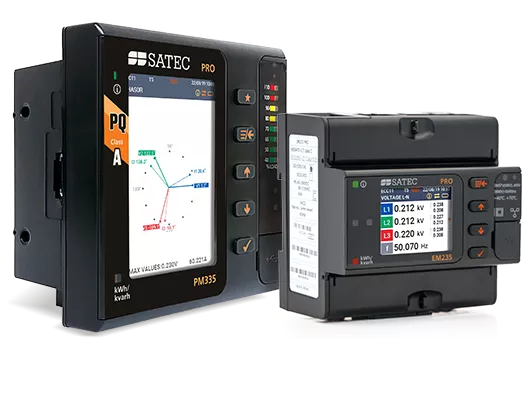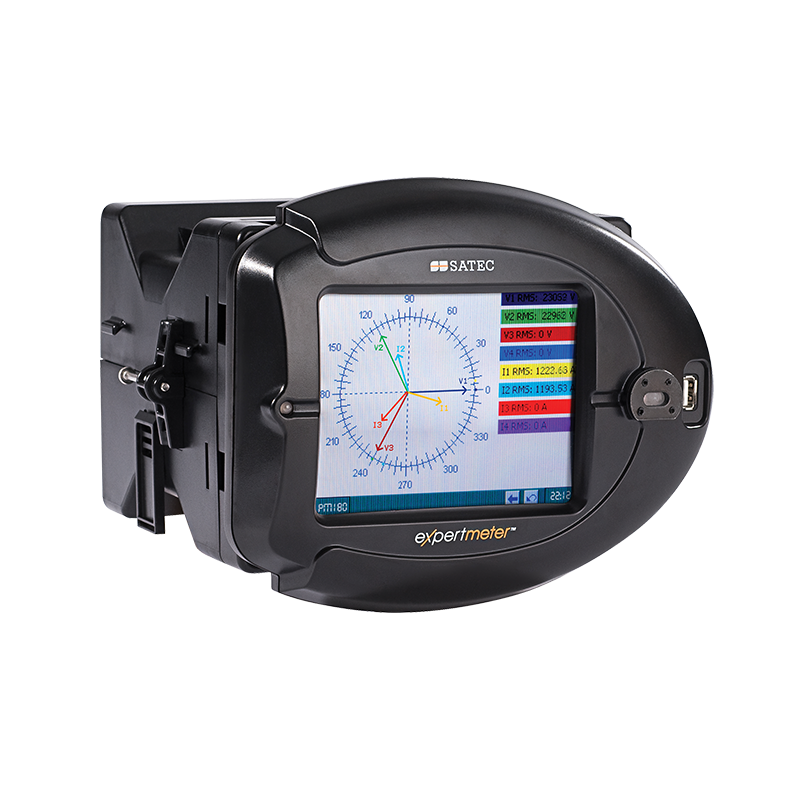Power quality is a key consideration for any electrical system, as disturbances in the power supply can lead to equipment malfunctions, energy inefficiency and increased operational costs. Monitoring and analysing the power quality of electrical systems is critical for ensuring the reliability of power delivery and preventing long-term damage to sensitive equipment.
IEC 61000-4-30 is the international standard for power quality measurement. It defines the methods for assessing the quality of AC power supply systems and offers classifications for various measurement instruments based on their performance accuracy. The standard is particularly focused on disturbances in voltage, frequency and other electrical parameters that can affect the operation of electrical equipment.
The most common accuracy classes within the IEC 61000-4-30 standard are Class A and Class S. These classes define the precision and performance of power quality meters, which are used to measure critical parameters such as voltage sags (dips), swells, harmonics, transients, flicker and other power quality events.
What is Power Quality?
Power quality refers to the consistency and reliability of the electrical power supplied to equipment. High quality power should have a constant voltage, frequency and waveform, without interruptions, spikes, or dips. Power quality problems occur when there are deviations from this ideal, which can negatively affect electrical equipment and processes.
Common power quality issues include:
- Voltage sags and dips: Temporary decreases in voltage that may cause equipment malfunction.
- Voltage swells: Brief increases in voltage that can damage sensitive equipment.
- Transients: Short, high-energy disturbances typically caused by lightning strikes, switching operations or faults in the power system.
- Harmonics: Distortions in the voltage or current waveform caused by non-linear loads such as computers, LEDs and variable frequency drives.
- Flicker: Visible fluctuations in lighting due to rapid changes in voltage.
Understanding these issues is vital for both utilities and businesses to ensure continuous, reliable power supply.
Understanding Power Quality Parameters under IEC 61000-4-30
IEC 61000-4-30 outlines several key power quality parameters that are monitored and measured to evaluate the health of the electrical supply:
Voltage Sags/Dips:
These occur when the voltage drops for a short period of time. A sag can cause equipment to trip or restart, especially in sensitive devices. It’s essential to detect and correct voltage sags to ensure continuous power delivery.
Voltage Swells:
Voltage swells are increases in voltage for a short duration, often occurring when large loads are switched off. These can damage electrical equipment, especially devices sensitive to voltage fluctuations.
Flicker:
Flicker refers to fluctuations in voltage that cause noticeable changes in lighting levels. It is particularly problematic in industrial and residential lighting systems.
Harmonics:
Harmonics are unwanted frequency components that distort the normal sinusoidal waveform. These are typically generated by non-linear loads and can lead to heating in electrical components, leading to reduced efficiency and potential failure.
Interharmonics:
These are frequencies that fall between the harmonic frequencies and can cause disruption in electrical equipment. Their measurement is crucial for systems operating under variable loads.
Current Unbalance:
This occurs when the current flowing in three-phase systems is not equally distributed. This can lead to overheating and inefficiencies in motors and transformers.
Power Frequency:
This refers to the frequency at which the AC power supply operates (50Hz or 60Hz). Fluctuations in power frequency can cause problems with synchronous machines.
By monitoring these parameters, power quality meters provide critical data that can be used to mitigate potential issues before they affect the operation of the electrical system.
Global Relevance of IEC 61000-4-30 Standards
The IEC 61000-4-30 standard plays a crucial role in global power quality monitoring. It provides guidelines for manufacturers and utilities worldwide to standardise their equipment and measurement protocols. This standard has been adopted by many countries to maintain a consistent approach to power quality, particularly in sectors such as energy, telecommunications and manufacturing.
Governments and regulatory bodies use this standard to ensure the quality of the electrical supply and to enforce compliance with power quality regulations. In regions where the quality of electricity is closely monitored, such as the European Union, North America and parts of Asia, IEC 61000-4-30-compliant devices are necessary for regulatory compliance and performance testing.
Applications of Class A and Class S Meters
Class A Meters in Critical Infrastructure
Class A meters are ideal for high-precision measurements and are used in critical infrastructure systems, including:
Utility Monitoring: Utilities use Class A meters to monitor the power quality of the electrical supply and ensure compliance with local standards. These meters are used to track long-term trends in voltage stability, harmonics and other quality metrics.
Energy Audits and Load Studies: In large industrial plants, Class A meters are used for energy audits and efficiency studies. They provide detailed data about power quality, which helps in identifying inefficiencies, reducing energy consumption and improving operational costs.
Contractual Applications: For businesses or utilities that need to resolve disputes related to power quality or verify compliance with contractual agreements, Class A meters are essential. These meters are precise and provide verifiable results that can be used in legal or contractual settings.
Pictured right: The PRO Series – Class A and Class S available
Class S Meters for Surveys and General Monitoring
Class S meters are used for general monitoring and statistical purposes, such as:
Power Quality Surveys: These meters are typically used in surveys to assess the overall quality of the electrical system in a particular region or sector. They can be used across multiple sites to identify widespread power quality issues.
Long-Term Monitoring: Class S meters are ideal for long-term power quality monitoring in facilities, identifying recurring disturbances that may not cause immediate problems but could be indicative of future risks.
Industrial Research: In industrial research, Class S meters are used to collect data over long periods, enabling researchers to monitor how power quality events evolve and their effects on equipment performance.
Pictured right: PM180 Power Quality Analyser
Technological Advancements in Power Quality Measurement
Power quality measurement technologies have evolved significantly, with advances in digital signal processing (DSP), software analytics and IoT connectivity. Modern power quality meters are more capable than ever, offering the following advancements:
Higher Sampling Rates: Recent advancements in sampling technology allow for higher resolution measurements. This enables power quality meters to detect fast transients and disturbances that could otherwise be missed.
Wireless Monitoring: Many power quality meters now feature wireless communication, enabling real-time data transfer and remote monitoring. This reduces the need for physical checks and ensures faster response times for potential disturbances.
Cloud-Based Data Analysis: Modern power quality meters come with cloud-based platforms that store large volumes of data. This facilitates long-term analysis, easy access to data from remote locations and the ability to integrate the data with other monitoring systems.
Integration with Smart Grids: Power quality meters are increasingly integrated into smart grid systems, enabling real-time feedback loops that improve grid stability and performance.
Choosing the Right Power Quality Meter
When selecting a power quality meter, it’s crucial to consider the following factors:
Application Requirements: Are you performing high-precision measurements or general surveys? Class A meters are ideal for critical measurements, while Class S meters are sufficient for routine monitoring.
Accuracy and Precision: If the measurements will be used for regulatory compliance or resolving disputes, Class A meters should be your choice. For less stringent applications, Class S meters are more cost-effective.
Sampling Rate: High-frequency events require a higher sampling rate, which is available in Class A meters.
By selecting the right meter for your specific needs, you can ensure that your system operates efficiently and that power quality issues are promptly identified and addressed. Talk to our team of experts today.





